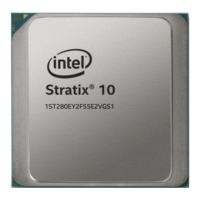6.4.2. nSTATUS
nSTATUS has the following two functions:
•
To behave as an acknowledge for nCONFIG.
•
To behave as an error status signal. It is important to monitor nSTATUS to identify
configuration failures.
Note:
nSTATUS does not go low for PR failures.
Generally, the Intel Stratix 10 device changes the value of nSTATUS to follow the
value of nCONFIG, except after an error. For example, after POR, nSTATUS asserts
after nCONFIG asserts. When the host drives nCONFIG high, the Intel Stratix 10
device drives nSTATUS high.
In previous device families the deassertion of nSTATUS indicates the device is ready
for configuration. For Intel Stratix 10 devices, when using Avalon-ST configuration
scheme, after the Intel Stratix 10 device drives nSTATUS high, you must also monitor
the AVST_READY signal to determine when the device is ready to accept configuration
data.
nSTATUS asserts if an error occurs during configuration. If an error occurs during
configuration, the length of the nSTATUS low pulse varies depending upon the type of
failure. The pulse ranges from .5 ms to 1.5 ms.
nSTATUS assertion is asynchronous to data error detection. Intel Stratix 10 devices do
not support the auto-restart configuration after error option.
Previous device families implement the nSTATUS as an open drain with a weak
internal pull-up. Consequently, you cannot wire OR an Intel Stratix 10 nSTATUS signal
with the nSTATUS signal from earlier device families.
Debugging Suggestions
Ensure nSTATUS acknowledges nCONFIG. If nSTATUS is not following nCONFIG, the
FPGA may not have exited POR. You may need to power cycle the PCB.
6.4.3. CONF_DONE and INIT_DONE
For Intel Stratix 10 devices, both CONF_DONE and INIT_DONE share multiplexed
SDM_IO pins. Previous device families implement the CONF_DONE and INIT_DONE
pins as open drains with a weak internal pull-up. Consequently, you cannot wire OR an
Intel Stratix 10 CONF_DONE or INIT_DONE signal with the nSTATUS signal from
previous device families. Otherwise, CONF_DONE and INIT_DONE behave as these
signals behaved in earlier device families. If you assign CONF_DONE and INIT_DONE
to SDM_IO16 and SDM_IO0, weak internal pull-downs pull these pins low at power-on
reset. Ensure you specify these pins in the Intel Quartus Prime Software or in the Intel
Quartus Prime settings file, (.qsf). CONF_DONE and INIT_DONE are low prior to and
during configuration. CONF_DONE asserts when the device finishes receiving
configuration data. INIT_DONE asserts when the device enters user mode.
Note:
The entire device does not enter user mode at the same time.
6. Intel Stratix 10 Debugging Guide
UG-S10CONFIG | 2018.11.02
Intel Stratix 10 Configuration User Guide
Send Feedback
102

